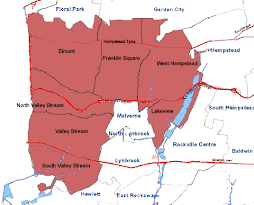Plants to Be Installed in Elmont and Franklin Square
The Western Nassau Water Authority adopted its Operating Plan and Capital Plan for the 2010-2011 fiscal year at its most recent Board of Directors Meeting. Among the contents of the Capital plan included the construction of two iron removal plants in Elmont and Franklin Square.
The Water Authority’s operating revenues for the next fiscal year will total $11,896,140. The projected revenues in the plan will require an increase of $850,000 (7.24 percent) to cover costs of new financing. Its total expense forecast, according to the operating plan, is $3,803,920 which goes towards wages. Seventy-four percent ($3,048,180) is charged to the Operation and Maintenance Expense.
The Capital Plan’s monetary total was adopted at $8,228,375. The installation of new iron removal plants in Elmont water wells 28A and 28B are due to high iron concentration levels in the water. This drew the ire of residents and they’ve requested immediate action. The plan to address iron removal also includes the replacement of 8,300 feet of 8-inch water main, 18 hydrants and 210 water services in the areas of Lorraine Drive and Ferngate Drive and continued flushing activities in Franklin Square.
High iron levels in water lead to discolored water issues that affect residents, such as stained clothes and discoloration of plumbing fixtures. Residents and business owners noted this during the water quality hearing that took place on May 17.
According to documents pertaining to the iron issues, iron in the water from Well 28A is sequestered before it’s pumped into the distribution system. However, Well 28B has not been in use since the iron levels exceed levels that can be sequestered. The estimated cost of the Elmont wells is estimated at $500,000.
The Water Authority will be installing another iron filtration plant near Well 30 in Franklin Square. According to the capital plan, that well has high iron levels because of the aquifer in where it’s located. The cost to build the plant at Well 30 is estimated at $400,000.
The Water Authority stated that Well 30 is sequestered just like Well 28A in Elmont. The sequestering agent combines with the iron in the water to prevent discoloration of the water. Yet, it’s still coming up murky and sometimes black.
High iron levels can also add a metallic taste to the water. This mirrors the statement of Elmont resident Mimi Pierre-Johnson on May 17.
Senator Craig Johnson (D-Port Washington) held the hearing to address the water quality concerns in western Nassau. The Water Authority said Elmont’s water has high iron content, but is safe to drink. According to Water Authority Superintendent Michael Tierney, the two plants are the first step in iron filtration.
“This plant that we’re submitting to the board for their consideration; we have a number of things in regard to the water quality in Franklin Square [and Elmont],” Tierney said. “Those are the bigger projects. We recently replaced an extensive piece of a [water] main in Franklin Square off Swale Road. We anticipate in continuing the process. Not only in replacing distribution mains, but installing removal plants as well.”
Tierney said that it’s an issue the Water Authority is addressing but that it’s not going to happen overnight. He said it’s going to take time. Tierney iterated that the board does not want to leave any stones unturned in wake of the recent concerns of Nassau residents.
“The distribution mains are old and there’s a lot of iron buildup on the south shore,” he said. “We are presently researching and reaching out to consultant groups to have them design and construct these [iron filtration] plants.”
Franklin Square resident Marissa Gregorio addressed the board during public session and stated her issues and concerns of the water. With her 6-month-old baby girl in her arms, Gregorio stated that, “If I would’ve known this [about the water], I never would’ve bought the house.”
Gregorio said she can barely bathe her children in the water because of its dark brown color from time to time and that it’s becoming more frequent. She wants something done immediately. The board assured her that they’re doing everything possible to address the issue. “My bottom line question is ‘When are we going to have clean water?’” “That’s my main concern,” she said.
Water Authority President John E. Ryan said that he’d rather give a fixed date as to when the project will yield results, but would not want to mislead anyone because, as Tierney said, these things take time.
“This is naturally occurring iron in the ground,” Ryan said. “We’re going to try everything we can but I would not want to tell you by whatever date that you’ll have clean water because that wouldn’t be fair. We’re doing the best we can.”
Tierney said the Water Authority has met with the Department of Health to approve the plants. He said this is where the outside consultants come into play, “to actually design the plants. The Department of Health is behind us. We have to get bids together, put them out and start our bids within this year’s capital plan. Our hope is to have this done this year and I believe we will.”
Ryan commented on the water quality hearing by Senator Johnson and stated that the treatment of Chief Engineer Robert Swartz was unfair and that, “he was asked things that were not part of his job.”
During the May 17 hearing, there were a number of informational requests made by Senator Johnson toward the Water Authority and Ryan said that they’d comply as soon as Johnson sends the request. Tierney stated that there have been no requests made by Senator Johnson as of yet.
“We have not heard anything back,” he said.
Tuesday, June 22, 2010
Subscribe to:
Post Comments (Atom)



No comments:
Post a Comment